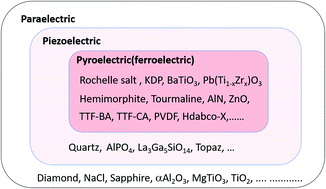Chemical design of a new displacive-type ferroelectric†
Abstract
Since the discovery of the ferroelectric perovskite-type oxide BaTiO3 in 1943, numerous materials have been surveyed as candidates for new ferroelectrics. Perovskite-type materials have played a leading role in basic research and applications of ferroelectric materials since the last century. Experimentalists and theoreticians have developed a new materials design stream for post-perovskite materials. In this stream, we have mainly focused on the role of covalency in the evolution of ferroelectricity for displacive-type ferroelectrics in oxides. This perspective surveys the following topics: (1) crossover from quantum paraelectric to ferroelectric through a ferroelectric quantum critical point, (2) the role of cation–oxygen covalency in ferroelectricity and the crossover to quantum paraelectric in perovskite-type compounds, (3) off-center-induced ferroelectricity in perovskites, (4) second-order Jahn–Teller effect enhancement of ferroelectricity in lithium-niobate-type oxides, (5) the presence of four ferroelectric phases and structural transitions of phases of AFeO3 with decreasing radius of A (A = La–Al), (6) tetrahedral ferroelectrics of perovskite-related Bi2SiO5 and wurtzites, (7) a rare type of polarization switching system in which the coordination number of ions in κ-Al2O3 systems changes between 4 and 6, and (8) lone-pair-electron-induced ferroelectrics in langasite-type compounds.

- This article is part of the themed collection: 2022 Frontier and Perspective articles


 Please wait while we load your content...
Please wait while we load your content...